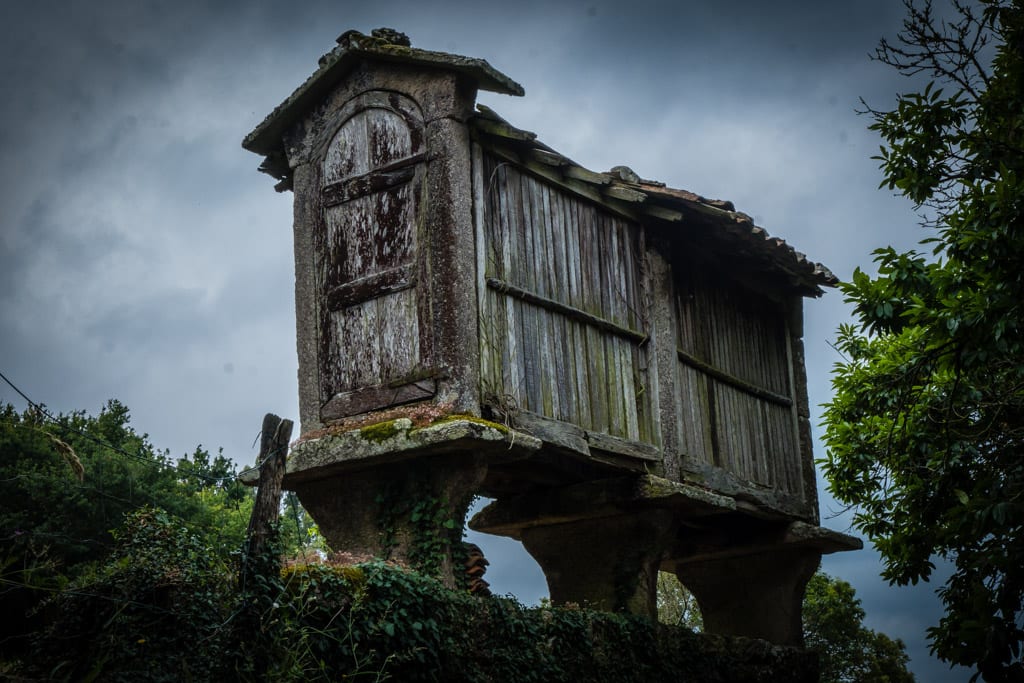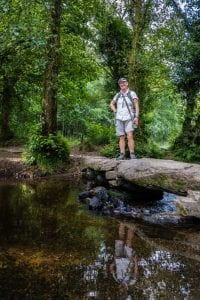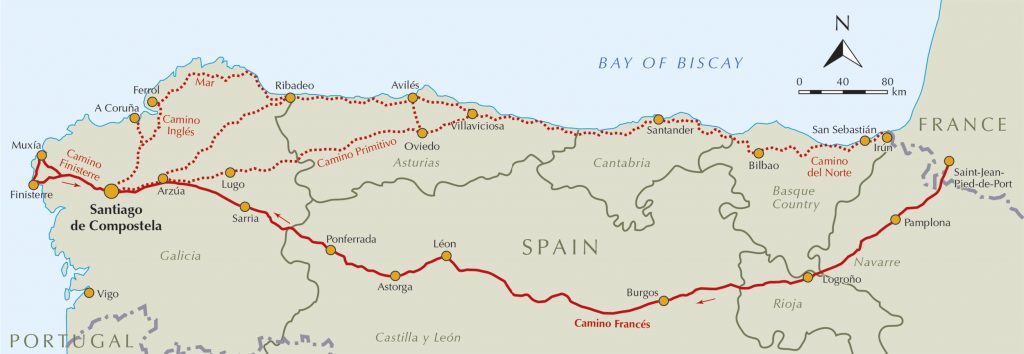Encapsulating the third major stage of the French Way, from the city of Léon to Santiago de Compostela, this 16-day pilgrimage is a complete walk in itself.
Camino de Santiago: Camino Frances (The French Way)
16 days / Self-guided walking
Léon to Santiago de Compostela
Camino Frances (The French Way)
TRIP STYLE
DURATION/LENGTH
16 days/276 kms
DATES
Any date to suit you
START/END POINT
Léon to Santiago de Compostela
GRADING
Moderate Walk
PRICE P/P TWIN SHARE
From EURO 1,485 / AUD 2,395

Starting under the gaze of Léon’s spectacular cathedral, this pilgrimage follows the French Way of the Camino de Santiago through a variety of memorable landscapes and towns. From Astorga and its Gaudi-designed palace to the magical peak of O Cebreiro, pilgrims will experience Spain’s famous hospitality in both rural and urban settings while walking through farmlands and forests and over mountain passes. With the spires of Santiago’s cathedral waving you in, the physical heights you reach along the way will almost certainly be matched by the emotional rewards at the end.
Day 1 | Arrive Léon
Celebrated for its stunning gothic cathedral, Léon is a memorable place to commence your journey along the Camino de Santiago. The city’s old town is a winding maze of alleyways replete with bars and cafés, which are perfect for shaking off jet lag and soaking up the atmosphere. You’ll no doubt see fellow pilgrims, or ‘peregrinos’, either passing through or enjoying the city as an overnight stop. Be sure to visit the cathedral and witness the sun streaming through its stained-glass windows.
Day 2 | Léon – Astorga | 16 km / 4 hours
Enjoy breakfast then transfer from Léon to the small village of Hospital de Orbigo, where you’ll begin walking to Astorga. The walking today features some lovely landscapes and a couple of inclines as you approach Astorga. Perfectly positioned on a high hilltop, the city offers a rare opportunity to see the unique architectural work of Antonio Gaudi outside of Barcelona. Astorga’s Episcopal Palace is quintessential Gaudi, while the town itself is known for making chocolate as well as the famous ‘mantecadas’. These sponge pastries are a cross between a muffin and a scone and can be seen in all the bakery windows – treat yourself to two.
Day 3 | Astorga – Rabanal | 20 km / 5 hours
Set off from Astorga’s Plaza Mayor and follow the Camino’s yellow arrows along a well-marked trail. A day of beautiful countryside walking lies ahead as you follow the path through quaint villages and up a steady climb to Rabanal del Camino, your home for the evening. In the 12th century this place was home to a hermit named Gaucelmo, who dedicated his life to helping pilgrims on their way to Santiago. At 7 pm it’s sometimes possible to watch the local monks hold a Gregorian chant service at the Monasterio Benedictino, which is a memorable Camino experience.
Day 4 | Rabanal – Molinseca | 25 km / 6 hours
Continue climbing from Rabanal into the mountains and reach Foncebadon, a crumbling village with lovely views. Above Foncebadon is the Cruz de Ferro (Iron Cross), an important – and often moving – point on the Camino de Santiago. Pilgrims traditionally carry a stone from their home country and place it at the bottom of the cross, along with notes and photos of loved ones. It’s worth spending some time reading some of the stories and seeing the impact the Camino has had on so many people.
Walk a little further from the Cruz de Ferro and you’ll hit the Camino’s highest point before beginning the steep descent to Molinseca. You’ll lose approximately 1000 metres in elevation but Molinseca, which is situated next to a lazy river, is an ideal spot to rest up and soak your eet with your fellow pilgrims.
Day 5 | Molinseca – Cacabelos | 24 km / 5 hours
Spoilt once more with both views of rolling hills and friendly villages, you’ll find plenty of places to stop today for a relaxed lunch or to pick up some local produce for a picnic. You’ll also pass through Ponferrada, one of the larger cities on the route, where you can pick up supplies and explore the Castillo de los Templarios, a castle built by the Knights Templar with a moat and drawbridge. Today’s path is relatively flat and a welcome opportunity to enjoy a relaxed walking pace. Cacabelos, where you’ll spend the night, is also known for its red wines produced from the mencia grape.
Day 6 | Cacabelos – Herrerias | 25 km / 5–6 hours
Today’s goal is the small town of Herrerias. You are once again beginning to move into the mountains and tomorrow will be an incredible ascent to O Cebreiro, one of the highlights of the Camino. Some pilgrims attempt to reach O Cebreiro in one day but it’s far more enjoyable to reach the summit after a good night’s rest. After all, there’s no point rushing anything on the Camino.
Day 7 | Herrerias – O Cebreiro | 10 km / 3 hours
Sitting at 1300 metres above sea level, O Cebreiro overlooks the surrounding landscape and marks the border between the regions Castilla y Léon and Galicia. The settlement wouldn’t exist without the Camino and the Camino wouldn’t be as special without this magical enclave, which houses the second Holy Grail – a chalice used by a priest while conducting a mass in the 14th century, during which bread and wine turned to flesh and blood. The mountain is often shrouded in an eerie mist, with small stone huts dotting the summit and restaurants serving up ‘pulpo’ (octopus), along with Galician stew and a delicious local cheese shaped like a hat or a breast, ideally served with a drizzle of honey. The stone village of O’Cebreiro is a truly special Camino moment and you’ll have plenty of time to soak everything up.
Day 8 | O Cebreiro – Triacastela | 21 km / 5 hours
The morning descent from O Cebreiro is breathtaking (in the best way possible) and you’ll remember the views forever. Today’s route takes you along dirt tracks, through fields and past the hill of San Roque – where there’s a statue of a pilgrim on its way to Santiago. Triacastela was named for the three castles that once existed; however, unfortunately none exist today. Even so, the town is welcoming and the main street – Avenida Camilo Jose Cela – is lined with bars, restaurants and supermarkets catering to weary pilgrims.
Day 9 | Triacastela – Sarria | 19 km / 5 hours
Enjoy a pleasant morning stroll through town before tackling the climb up to Sanxil. The ascent is steep at times but the walking is lovely, with the path weaving through forested areas before reaching the peak. From here it’s a steady descent to Sarria, which is a key town for the Camino. Many pilgrims begin their journey here as they must walk at least 100 km to receive their ‘compostela’, or certificate, after arriving in Santiago. This is also the town where King Alfonso IX died while making his own pilgrimage to Santiago.
Despite the uptick in foot traffic, Sarria is atmospheric town and home to a beautiful, historical village in its upper section. You can visit both the Torre del Batallon – a medieval tower – and the Monasterio de La Magadalena, a former monastery that has been converted into a hotel. With only 120 km until Santiago, it’s easy to get caught up in the excitement over the ‘finish line’, but remember, the only thing that matters during the Camino is the next footstep and whoever you’re sharing that with.
Day 10 | Sarria – Portomarin | 23 km / 5 hours
Make the most of your day with an early start along the Rua Major with the old streetlamps lighting the way. Today’s walk to Portomarin will see you travel through at least five villages before arriving via the Camino’s longest bridge, which offers memorable views of the surrounding landscape.
This isn’t actually Portomarin’s original location. It was moved in the 1960s after the Miño River was dammed, leaving the old town underwater, and the historic buildings were rebuilt brick-by-brick in the new location. These days Portomarin is a top spot for an afternoon drink and a well-earned meal. Be sure to taste the town’s tarts and liqueurs, for which it is very well known.
Day 11 | Portomarin – Palas de Rei | 25 km / 6 hours
Today’s walk, which is on the longer side, is a pleasant amble through farming regions, sunflower fields and a number of picnic areas. There are fewer villages along the route so it’s the perfect opportunity to soak up the countryside and enjoy some alone time or the company of your fellow pilgrims. Palas de Rei is a small, welcoming town typical of the Camino, with about 3,700 residents.
Day 12 | Palas de Rei – Melide | 14 km / 3–4 hours
A shorter distance with undulating terrain, today’s walk will see you travel through Casanova and O Coto on your way to Melide. This is where the Camino Frances and the Camino Primitivo – which starts in Oviedo – meet each other and the town has been linked with the Camino de Santiago for centuries. The ‘Pulperia Ezequiel’ is particularly well known for its octopus and the Terra de Melide museum, housed in an old pilgrim hospital, provides interesting information about the region’s history.
Day 13 | Melide – Arzua | 15 km / 4 hours
Much of the day is spent walking through pleasantly shaded oak and eucalyptus forests. This is cattle country and there are more cows than people, though more pilgrims will join you, as Arzua is where the Camino del Norte (the Northern Way) joins the French Way. Arzua is home to Capilla de la Magdelena, a 14th century chapel, and also the perfect place to sample the local cheese, Queixo, a smooth cheese made from cows’ milk, worthy of its own festival in March.
Day 14 | Arzua – Rua | 20 km / 4 hours
The penultimate day of your pilgrimage is a thrilling experience and it’s impossible not to smile along with the other pilgrims and the locals. Tomorrow will be an emotional one, so make the most of a final opportunity for reflection along the path. Rua is a small town with Roman history, and may well be your last opportunity to meet strangers along the Camino. Share wine and experiences with your fellow pilgrims, both new and old, and enjoy a good rest so you’re fully charged for tomorrow’s walk into Santiago.
Day 15 | Rua – Santiago de Compostela | 20 km / 4–5 hours
The final day of pilgrimage is a bittersweet affair and you’ll no doubt wish that your journey was not ending. But if the pilgrimage teaches anything it’s acceptance and the final five kilometres, from which Santiago is visible, are some of the most memorable steps you’ll take. Wind your way through the city’s alleys to the steps of the cathedral and soak it up – it’s just as rewarding watching other pilgrims arrive.
When you’re ready you’ll take a trip to the Compostela office to receive your certificate – then it’s time to celebrate. And when it comes to celebrating, Santiago is one of the best. The stunning old town has an endless supply of chorizo, tortilla, Iberico jamon, pulpo and wine, while the atmosphere is unbeatable.
Day 16 | Santiago de Compostela
Your pilgrimage comes to its end after breakfast today and while the Camino may be finished, the memories live on.
Visit www.wanderingtheworld.com.au for more information.
Inclusions
- 15 nights accommodation, all carefully selected to enhance your Camino experience
- Private en-suite facilities
- Daily luggage transfers from hotel to hotel (1 x 20kg bag unless indicated otherwise)
- Daily breakfast
- Information packs with route maps and instructions on how to locate hotels
- Luggage identification tags
- Pilgrim’s passport
- Emergency contact details and 24/7 local on-the-ground support
- Pre-departure and ongoing support from Australian office
Optional Inclusions
- Three-course dinners with local wine
- Suggested rest days as outlined in itinerary or if required
- Upgraded accommodation including paradors, country properties and premium/high-end styles
- Private vehicle transfers to the trip’s starting point
- Single supplement for your own room
- Additional night’s accommodation before or after trip (please advise at time of booking)
Not Included
- Flights
- Travel to trip’s starting point
- Transfers not already outlined in detailed trip itinerary
- Lunches
Accommodation
We know from personal experience that a good night’s rest can make or break a trip, which is why we carefully hand-select all our accommodation. We ensure that our knowledge and firsthand experience of the best places to stay is passed on to all our walkers.
Your accommodation along the Camino is booked in advance, on a twin-share basis with private facilities, and chosen to make your pilgrimage experience as rewarding as possible. You may be staying in a refurbished farmhouse, some of which have been in the same family for centuries, or perhaps a boutique hotel with a chef who would not be out of place in a Michelin-starred restaurant. There are unique properties scattered throughout the different routes including converted monasteries, lighthouses and tiny B&Bs with the most generous hosts you could possibly imagine. Best of all, you’ll always have private en-suite facilities. Wherever you end up, you’ll be well looked after, warm and comfortable and, most importantly, ready to tackle the next day’s walk.
Single supplements are also available so you can enjoy your room with private en-suite. This supplement will apply if you are travelling alone or if there is no gender-share option. You can request a shared room through Wandering the World at the time of booking, however this is not guaranteed.
There are opportunities to upgrade to more luxurious lodgings in many places along the Camino. These are perfect for celebrating special occasions and milestones, or even to enhance your entire journey. We can recommend some very special, unique places to indulge in the Camino hospitality in spectacular style, so please ask us about these options when booking.
Food & Dining
The local cuisine is a definite highlight of your walk. The Camino regions are famous for their culinary delights, and you’ll end up exploring the destination using not only your feet, but also your taste buds.
Breakfast at your place of accommodation is usually continental style and may include cereals, yoghurt, bread, pastries, ham, tea, coffee and juices.
Lunch – at your own expense – will depend on where you are on your walk and what is available. It’s often purchased at a local café or bar, with choices along the trail perhaps including Spanish omelette (tortilla Espanola), tuna empanadas, soups or sandwiches (boccadillo). Alternatively, you may wish to enjoy a picnic in a perfect spot along the path.
Evening meals are a hearty, three-course affair known as the ‘pilgrims’ menu’. These usually consist of a salad or soup to start, followed by a choice of a meat or pasta dish, then finishing with a dessert. This is always accompanied by a bottle of local wine, of course. On occasion, the owner of the accommodation may be in the kitchen preparing the house special, which will not disappoint.
Most evening meals are included on guided group trips, and for self-guided itineraries, Wandering the World can include as many evening meals as you wish. We may strongly recommend this in some places because it’s either been a long walking day or there are limited choices available in certain destinations. We can share our advice and talk to you about this at the time of booking. We can accommodate most dietary requirements, so please let us know in advance.
THE WALKING
This trip is a self-guided itinerary, ideal for groups and independent travellers who prefer to navigate in their own way and their own time.
You will be provided with an information pack including easy-to-read maps and instructions, complete with directions to guide you on the well-marked paths and tracks. On the Camino, you will be following the yellow arrows and Camino scallop shells, while the Chemin is marked with red and white stripes. This information pack will be available at your joining hotel on the first day of your trip.
TRIP GRADE
Moderate – This itinerary is carefully designed for easy-to-manage walking days that generally average less than 20 km, or approximately 4–6 walking hours. The surfaces are fairly even with moderate ascents and descents. A reasonable level of fitness is recommended.
Given you only need carry a lightweight day pack, this trip is very manageable for those who are new to walking holidays. Whatever your previous experience, preparation and training make all our walks more enjoyable.
LUGGAGE TRANSFERS
Wandering the World arranges a daily luggage transfer to maximise your comfort and enjoyment, so all you need to carry is a day pack. Luggage allowance is one bag per person of no more than 20 kg (13 kg on the Chemin). Your luggage must be left in the reception of your hotel before breakfast (8 am) each day.
Please note:
- It is essential to attach the bag tag provided to ensure your luggage is delivered to your next accommodation.
- Only one bag will be moved each day and additional charges will apply if your bag is heavier than 20 kg (13 kg on the Chemin).
- Should you require special arrangements for additional luggage transfers, these can be made ahead of time and must be paid as part of your final payment to Wandering the World.
GROUP SIZE
Wandering the World’s guided groups have a maximum group size of 12 participants. This small group size means that we have the flexibility to stay in a wider range of accommodations, can dine together in the evenings, have the freedom to walk alone or together, and there are more opportunities to get to know your travelling companions.
TRANSFERS/TAXIS
If, for any reason, you wish to shorten your walking day, there are options along the Camino and in the villages to arrange a taxi.
On some itineraries, there are times when Wandering the World may arrange a transfer for you or can do so at your request. This might happen where small villages do not have accommodation with private facilities, for example, or when we want to take you to a special country property that we know you are going to love. In this case, Wandering the World will either arrange a transfer for you or suggest a taxi.
Transfers on the Camino are common in parts. A simple procedure is outlined in your trip notes explaining the details of your private transfer, the designated meeting point and the agreed transfer time.
WEATHER
The weather and climate on the Camino can vary from country to country, region to region and, of course, from day to day. Each season has its own benefits, with long, warm and sunny days in spring and early summer, while early spring and late autumn tend to enjoy cooler walking temperatures. Some sections may be too hot for walking mid-summer, while others are more likely to be wet at certain times. The experts at Wandering the World can discuss your preferences and guide you when you are planning your trip.
Once you’ve started your walk, the weather can play an important role in your overall enjoyment of the journey. Checking the forecast can be a great help when planning your days. If you do strike hotter weather, leaving early to avoid the warmest part of the day will make a huge difference.
24/7 SUPPORT & CARE
Your information pack will include details of local emergency contacts and international contacts. We have local, on-the-ground support to provide any assistance you may require and we’ll also check-in with your hotel at the end of each day to ensure that you’ve arrived safely.
GETTING THERE / GETTING HOME
This itinerary begins in Léon and ends in Santiago de Compostela.
The closest airports to Léon are Madrid or Oviedo.
From your airport of choice there are bus, train and flight options as per the links below.
Train bookings are recommended. Please note you can only book two months in advance of the date of travel.
Bus: ALSA
Train:
Bus/Train : Rome2Rio
Flights:
Also, check out: Skyscanner OR Spanish Airport Guide
INSURANCE
Insurance is compulsory for everyone who travels with Wandering the World. The insurance policy must include cover against personal accident, medical expenses, emergency repatriation and personal liability. Wandering the World recommends insurance coverage for cancellation to be taken at the same time your deposit is paid, as no exception to the cancellation provisions can be made.
BOOKING AND TRAVEL TERMS AND CONDITIONS
Wandering the World’s full booking terms and conditions are available upon request and will also accompany your initial invoice for deposit.
 “Léon has a real charm, I like to stay in the old town, start with a tapas crawl and get excited about returning to Santiago (more than 20 times thus far)! I have some favourites on this path, Astorga with its impressive Gaudi architecture, O’Cebreiro a stone village so unique and quaint where they serve their local cheese drizzled with honey so fresh it could be squeezed straight from the bee…sublime!” – Glenyce, Founder of Wandering the World.
“Léon has a real charm, I like to stay in the old town, start with a tapas crawl and get excited about returning to Santiago (more than 20 times thus far)! I have some favourites on this path, Astorga with its impressive Gaudi architecture, O’Cebreiro a stone village so unique and quaint where they serve their local cheese drizzled with honey so fresh it could be squeezed straight from the bee…sublime!” – Glenyce, Founder of Wandering the World.
We just returned home from an amazing Camino trip ALL THANKS TO YOU! The lodgings, food, scenery and fellow pilgrims we met along the way were unforgettable. Each day we awoke rested and eager for the adventure which awaited us. Each lodging was unique and captured the Galician spirit. We enjoyed singing Gregorian chants with monks and sleeping in an old monastery, and the earthy meals served were to die for. Thank you for all your hard work in setting this up…truly the trip of a lifetime. We’ll cherish the memories forever.
Kit & John, Camino Frances, 2019
I just wanted to say thank you so much for the organising of our wonderful Camino journey. Once we worked out the first few days of transfers etc all went really well…and there was never a hitch along the way in any shape or form. Our baggage was delivered each day, and we were transported and picked up right on time…it was all superb
I just loved walking on the Camino…it was something special and I know that I would like to go back. I loved Spain and the people…the food was great, wine was amazing and shopping good…and would love to experience it again…sooner rather than later. I have recommended your company to many during our travels.
Jan B – Camino Frances, 2019

